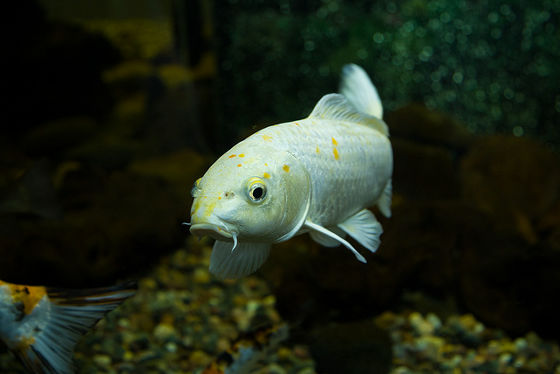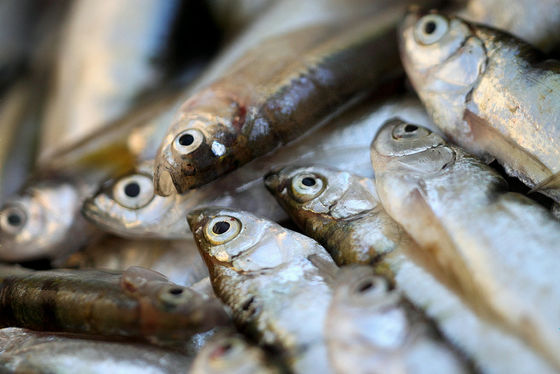The view that "fish feels pain" is spreading even among researchers

Byliz west
A fish swims in a big aquarium There are times when you can see a sight that you can swim in a cup with the fish half cut off in a cistern. It seems to be painful to see fish with bones exposed, but there are many people who have had a conversation saying, "In fact, fish do not feel pain" with a description saying, "I feel relieved. However, in the science of recent years there is widespread view that fish has a feeling close to some sort of pain.
It's Official: Fish Feel Pain | Science | Smithsonian
https://www.smithsonianmag.com/science-nature/fish-feel-pain-180967764/
One of the grounds for the theory that "fish does not feel pain" is that "the nervous system of fish is not developed so complicatedly". The fish brain has primates such as humans and other mammalsCerebral cortexIt is based on that it is not equipped. When a stimulus is applied to the surface of the skin or the like, a mammal transmits a signal to the nerve cell, enters the spinal cord, the brain from the peripheral nerve, reaches the cerebrum through the hypothalamus, the thalamus, and the brain understands as a pain . Traditionally, it has been said that the brain senses pain in the thalamus, but due to the development of fMRI that can see the brain's activities in detail, the signal is actually processed at multiple parts of the cerebrum It is becoming clear that there is.
Certified NPO corporation painful medical research information center | About pain
http://www.pain-medres.info/about/about01_3.html
And there is a view that the fish does not feel pain because there are few cerebral cortexes constituting this cerebrum in the fish. In the Q & amp; A corner published in the American 'Field & amp; Stream' magazine published in 1977, fishing writer Ed Zane told a question from a 13 - year - old girl said, Pain felt when the skin turns, something sticks to your feet, teeth become painful with tooth decay can not be felt by the fish because the nerve of the fish is very simple.I have a fish I do not know if I feel the same kind of pain as a human being, but probably "There is a thing called" fish bruise "" I answer. Mr. Zane also replies, "If you prohibit someone catching fish, it will have a big impact on humans."
Such a theory still continues even today. In 2014, BBC invited Victoria Braithwaite, a biologist at Pennsylvania State University, and Mr. Bertie Armstrong, the head of the Scottish Fishery Federation, to discuss fish pain and welfare . Among them, Mr. Armstrong made the welfare for fish "creepy" and claimed that "from the scientific evidence fish do not feel the same pain as us." On the other hand, Mr. Brace Wheit argued that it is not important whether the fish has the same feeling as a human, "I also feel the pain of fish, the possibility that it is different from what human beings actually feel is Although it is thought that it is high, there is no difference that there is still some kind of pain. "
From an anatomical point of view, there are neurons called nociceptors in fish, and it is possible to detect latent "harm" such as high temperature, strong pressure, corrosive chemicals etc. We also know that fish also have a mechanism to produce opioids (analgesics) like mammals. And there is also a signal flow to some fish in the fish. Studies have found that electrical activity increases sharply from the nociceptor toward the brain when a needle is stabbed behind a goldfish or rainbow trout.

ByEmil.
In another way, research results suggesting that the fish also feels some kind of "distress" has also been reported. In one study, researchers dropped a bright-colored Lego block in a tank containing rainbow trout. In this case, rainbow trout is common to show reactions trying to avoid intruders in case of danger, but if you inject acetic acid that gives pain in rainbow trout in advance, rainbow trout against lego blocks He said he did not show a reaction. It is thought that rainbow trout could not afford to avoid the original evasion, because consciousness was directed to pain due to acetic acid.
In contrast, when you injected both acetic acid and morphine, which becomes an analgesic, you seem to be able to take normal avoidance behaviors. Morphine is not a substance that removes the cause of pain but a substance that inhibits the feeling of pain. This suggests that rainbow trout felt "spiritually" rather than "physiologically" the pain.
In another study, rainbow trout, which was injected with acetic acid on the lips, showed a movement to breathe elaborately, show the movement of moving back and forth at the bottom of the aquarium, rubbing the lips against the side of the gravel or aquarium Thing. And it has been revealed that it took twice as long to return to normal condition compared to rainbow trout which felt pain by adding physiological saline.

ByPatrick Breen
From these circumstances, the view that the sensation of a kind of "pain" also exists in fish has expanded support. When Lynn Sunadon, a biologist and Liverpool biologist and one of the world's fish pain experts, asked the question "Do you think the fish feels pain?" In 2003 , Only two people raised their hands. However, Mr. Sunadon said, "If you ask the same question now, almost everyone will win hands." In 2013, the American Veterinary Society Society denied the theory that the reaction of fish to pain is a mere reflection: the accumulated evidence suggests that fishes should take the same considerations as terrestrial vertebrates for salvage from pain We support the position that it should be given. "
There is such a trend, and in each country the way of welfare for animals is spreading. The UK has a progressive animal welfare law covering the most all non-human vertebrates. Animal welfare law in Canada and Australia is different depending on state and region, but it is said that it is finer. Some protect the fish, while others do not. The relevant laws in Japan hardly consider fish, and in China almost no substantial animal welfare law of all kinds exists. Every year in the world, 700 billion terrestrial organisms are killed for food. In addition, aquaculture consumes up to 100 billion fish each year, and 1 to 3 trillion fish of natural fish are captured.

By_paVan _
In many cases, landing fish are dying of suffocation caused by inability to breathe. In order to avoid this death accompanied by suffering, there was devised a method of giving an electric shock and not giving a pain by applying a kind of anesthetic and applying a blow while the fish faints, In fact there are a few fishing boats carrying such a device in the world. In addition, there are unexpected merits, and it seems that the result that the flesh which was shimmered momentarily without being given stress or fleshed improves meat quality has also been confirmed.

ByThomas Hawk
Related Posts:







